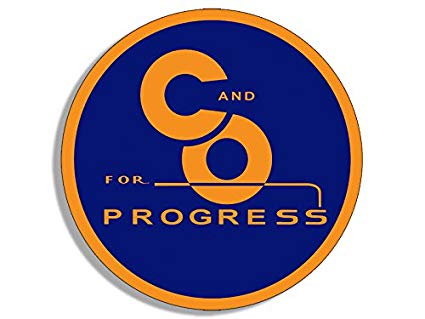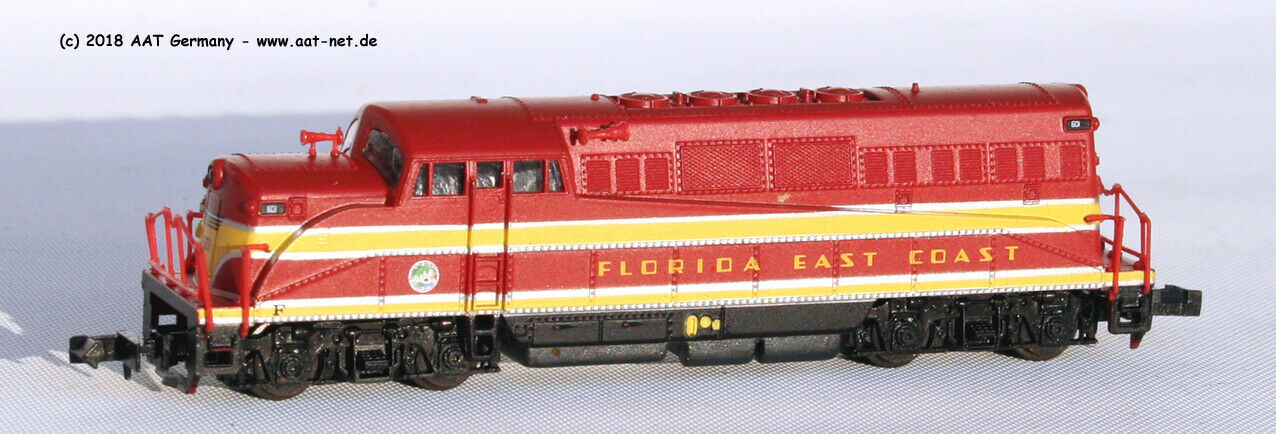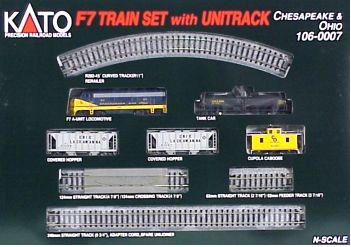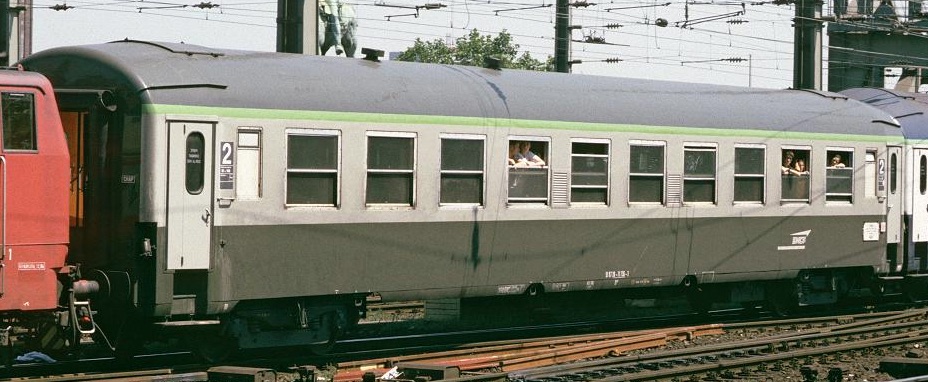Specific Item Information: Introduced in the 1968 catalog - disappeared a couple of years after.
Non prototypical, based on a European coach car.
Non prototypical, based on a European coach car.
Model Information: Introduced in 1968 as the first N scale Passenger car of Lima in its Italian Az version, this body style was then used for several other European road names up until the early 1980's.
With a length of 138mm, this car is shorter than the UIC-Y prototype; it should be 153 mm at N scale (1/160) to be prototypically correct.
It features 9 compartment windows like the UIC-Y prototype for 1st class, however this body style has also be used until 1978 for german DB A4üm cars that would in fact be of the UIC-X type with 10 compartment windows for 1st class.
For a short period of time after 1968, this body style has also been used repainted with North American paint schemes, until Lima introduced more prototypically correct body styles of North American Passenger cars.
With a length of 138mm, this car is shorter than the UIC-Y prototype; it should be 153 mm at N scale (1/160) to be prototypically correct.
It features 9 compartment windows like the UIC-Y prototype for 1st class, however this body style has also be used until 1978 for german DB A4üm cars that would in fact be of the UIC-X type with 10 compartment windows for 1st class.
For a short period of time after 1968, this body style has also been used repainted with North American paint schemes, until Lima introduced more prototypically correct body styles of North American Passenger cars.
Prototype History: The UIC (Union International des Chemins de fer) type Y is a type of passenger car defined in UIC bulletin 567 together with UIC type X. Initially ordered by the Italian Ferrovie dello Stato (FS), with 24 manufactured, they have primarily been produced for the French SNCF with 1,327 manufactured from 1963 to 1976.
The East German railways (DR) derived their OSJD/OSShD type B cars to deliver from 1966 to 1970 a new series close to the UIC-Y, and then from 1969 a series of type Y/B 70 that is compatible to UIC-Y standards. These Eastern German cars have been acquired by several railways of Eastern Europe: : Czechoslovakia (ČSD), Poland (PKP), Hungary (MÁV), Bulgaria (BDŽ), Romania (CFR).
The east-German UIC-Y cars have a higher roof than the French and Italian ones.
From Wikipedia (in French)
See also these detailed articles (in Italian) for more information about both the prototypes and the N scale models: UIC-Y and UIC-Y from SNCF.
The East German railways (DR) derived their OSJD/OSShD type B cars to deliver from 1966 to 1970 a new series close to the UIC-Y, and then from 1969 a series of type Y/B 70 that is compatible to UIC-Y standards. These Eastern German cars have been acquired by several railways of Eastern Europe: : Czechoslovakia (ČSD), Poland (PKP), Hungary (MÁV), Bulgaria (BDŽ), Romania (CFR).
- Ferrovie dello Stato (FS): 20 Az (1st class), 1 ABz, 1 Bz, 1 AcBcz and 1 Bcz;
- French National Railway Corporation (SNCF): 185 A9 (1st class), 43 A7D (1st class + Baggage), 53 A4B5 (1st/2nd class), 305 B10 (2nd class), 118 B5Dd2 (2nd class + Baggage), 175 A4c4B5c5x (1st/2nd class sleeper), 448 B9c9x (2nd class sleeper);
- Eastern Germany Railways (DR) - type Y : 22 Age (1st class), 66 ABge (1st/2nd class), 142 Bge (2nd class)
- Czech Railways (ČSD) - type Y/B 70 : 43 Ame (1st class), 60 Bme (2nd class), 7 BDmse (2nd class + Baggage).
The east-German UIC-Y cars have a higher roof than the French and Italian ones.
From Wikipedia (in French)
See also these detailed articles (in Italian) for more information about both the prototypes and the N scale models: UIC-Y and UIC-Y from SNCF.
Road Name History:  The Chesapeake and Ohio Railway (reporting marks C&O, CO) was a Class I railroad formed in 1869 in Virginia from several smaller Virginia railroads begun in the 19th century. Led by industrialist Collis P. Huntington, it reached from Virginia's capital city of Richmond to the Ohio River by 1873, where the railroad town (and later city) of Huntington, West Virginia was named for him.
The Chesapeake and Ohio Railway (reporting marks C&O, CO) was a Class I railroad formed in 1869 in Virginia from several smaller Virginia railroads begun in the 19th century. Led by industrialist Collis P. Huntington, it reached from Virginia's capital city of Richmond to the Ohio River by 1873, where the railroad town (and later city) of Huntington, West Virginia was named for him.
Tapping the coal reserves of West Virginia, the C&O's Peninsula Extension to new coal piers on the harbor of Hampton Roads resulted in the creation of the new City of Newport News. Coal revenues also led the forging of a rail link to the Midwest, eventually reaching Columbus, Cincinnati and Toledo in Ohio and Chicago, Illinois.
By the early 1960s the C&O was headquartered in Cleveland, Ohio, USA. In 1972, under the leadership of Cyrus Eaton, it became part of the Chessie System, along with the Baltimore and Ohio and Western Maryland Railway. The Chessie System was later combined with the Seaboard Coast Line and Louisville and Nashville, both the primary components of the Family Lines System, to become a key portion of CSX Transportation (CSXT) in the 1980s. A substantial portion of Conrail was added in 1999.
C&O's passenger services ended in 1971 with the formation of Amtrak. Today Amtrak's tri-weekly Cardinal passenger train follows the historic and scenic route of the C&O through the New River Gorge in one of the more rugged sections of the Mountain State. The rails of the former C&O also continue to transport intermodal and freight traffic, as well as West Virginia bituminous coal east to Hampton Roads and west to the Great Lakes as part of CSXT, a Fortune 500 company which was one of seven Class I railroads operating in North America at the beginning of the 21st century.
At the end of 1970 C&O operated 5067 miles of road on 10219 miles of track, not including WM or B&O and its subsidiaries.
Read more on Wikipedia.

Tapping the coal reserves of West Virginia, the C&O's Peninsula Extension to new coal piers on the harbor of Hampton Roads resulted in the creation of the new City of Newport News. Coal revenues also led the forging of a rail link to the Midwest, eventually reaching Columbus, Cincinnati and Toledo in Ohio and Chicago, Illinois.
By the early 1960s the C&O was headquartered in Cleveland, Ohio, USA. In 1972, under the leadership of Cyrus Eaton, it became part of the Chessie System, along with the Baltimore and Ohio and Western Maryland Railway. The Chessie System was later combined with the Seaboard Coast Line and Louisville and Nashville, both the primary components of the Family Lines System, to become a key portion of CSX Transportation (CSXT) in the 1980s. A substantial portion of Conrail was added in 1999.
C&O's passenger services ended in 1971 with the formation of Amtrak. Today Amtrak's tri-weekly Cardinal passenger train follows the historic and scenic route of the C&O through the New River Gorge in one of the more rugged sections of the Mountain State. The rails of the former C&O also continue to transport intermodal and freight traffic, as well as West Virginia bituminous coal east to Hampton Roads and west to the Great Lakes as part of CSXT, a Fortune 500 company which was one of seven Class I railroads operating in North America at the beginning of the 21st century.
At the end of 1970 C&O operated 5067 miles of road on 10219 miles of track, not including WM or B&O and its subsidiaries.
Read more on Wikipedia.
Brand/Importer Information: Lima N scale European models were numbered with 3 digits until 1978. They were renumbered after 1978 by adding "320" before the previous number. e.g. "306" became "320306".
Manufacturer Information:  Lima S.p.A (Lima Models) was a brand of railway models made in Vicenza, Italy, for almost 50 years, from the early 1950s until the company ceased trading in 2004. Lima was a popular, affordable brand of 00 gauge and N gauge model railway material in the UK, more detailed H0 and N gauge models in France, Germany, Italy, Switzerland, and the United States as well as South Africa, Scandinavia and Australia. Lima also produced a small range of 0 gauge models. Lima partnered with various distributors and manufacturers, selling under brands such as A.H.M., Model Power, Minitrain and PMI (Precision Models of Italy). Market pressures from superior Far Eastern produce in the mid-1990s led to Lima merging with Rivarossi, Arnold, and Jouef. Ultimately, these consolidations failed and operations ceased in 2004.
Lima S.p.A (Lima Models) was a brand of railway models made in Vicenza, Italy, for almost 50 years, from the early 1950s until the company ceased trading in 2004. Lima was a popular, affordable brand of 00 gauge and N gauge model railway material in the UK, more detailed H0 and N gauge models in France, Germany, Italy, Switzerland, and the United States as well as South Africa, Scandinavia and Australia. Lima also produced a small range of 0 gauge models. Lima partnered with various distributors and manufacturers, selling under brands such as A.H.M., Model Power, Minitrain and PMI (Precision Models of Italy). Market pressures from superior Far Eastern produce in the mid-1990s led to Lima merging with Rivarossi, Arnold, and Jouef. Ultimately, these consolidations failed and operations ceased in 2004.
Hornby Railways offered €8 million to acquire Lima's assets (including tooling, inventory, and the various brand names) in March of the same year, the Italian bankruptcy court of Brescia (town near Milan, last headquarters of Lima) approving the offer later that year. In December 2004, Hornby Railways formally announced the acquisition along with the Rivarossi (H0 North American and Italian prototypes), Arnold (N scale European prototypes), Jouef (H0 scale French prototypes), and Pocher (die-cast metal automobile kits) ranges. As of mid-2006, a range of these products has been made available under the Hornby International brand, refitted with NEM couplings and sprung buffers and sockets for DCC (Digital Command Control) decoders.
From Wikipedia

Hornby Railways offered €8 million to acquire Lima's assets (including tooling, inventory, and the various brand names) in March of the same year, the Italian bankruptcy court of Brescia (town near Milan, last headquarters of Lima) approving the offer later that year. In December 2004, Hornby Railways formally announced the acquisition along with the Rivarossi (H0 North American and Italian prototypes), Arnold (N scale European prototypes), Jouef (H0 scale French prototypes), and Pocher (die-cast metal automobile kits) ranges. As of mid-2006, a range of these products has been made available under the Hornby International brand, refitted with NEM couplings and sprung buffers and sockets for DCC (Digital Command Control) decoders.
From Wikipedia
Item created by: Alain LM on 2020-02-10 15:09:01. Last edited by Lethe on 2020-05-07 00:00:00
If you see errors or missing data in this entry, please feel free to log in and edit it. Anyone with a Gmail account can log in instantly.
If you see errors or missing data in this entry, please feel free to log in and edit it. Anyone with a Gmail account can log in instantly.









